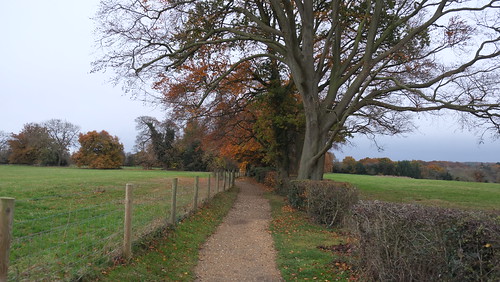After I finished my London publicity tour for Rest (which is coming out with Penguin Life in February 2017), my wife and I spent the weekend being tourists. On Saturday I did something I’ve long wanted to do, but never got around to: we went to visit Charles Darwin’s house in the village of Downe. I’ve written about the house, the nearby Sandwalk, and Darwin’s time there in my last two books, but I’ve never actually been there until now.
Darwin moved to Downe in 1842, to give himself more privacy and room to raise his growing family. He and his wife Emma both wanted to be in the country, and they intentionally chose a place that would not be very easy to get to.
It still isn’t.
First, you get to Charing Cross station, then take the train to the town of Orpington.
From there, you get the number R8 bus that makes the rounds through the country, and stops at Downe. You then walk about a third of a mile to Down House. All told, it’s about 90 minutes to get from Charing Cross to Down House, but in reality, it’s longer: the trains and buses aren’t likely to sync up perfectly. In our case, that was a bit fortuitous, as it allowed us time to have lunch at the Maxwell pub in Orpington.

After that, it was on the bus to Downe. When the roads are open, the bus stops right in front of Down House. This time, it didn’t, so we had to get off and walk.
However, this gave us a chance to visit the church in the village, which is really quite lovely.
There’s also a “Darwin Bar,” rather inevitably.

From the village, it’s a few minutes’ walk to Down House. However, it’s worth noting that much of the walk is along a narrow country road with hedges on either side and no sidewalk, so you really have to keep to the very edge of the road and yet let cars know that you’re there so they don’t accidentally run you over.
Eventually, though, you arrive at Down House.
The house itself has been part of National Trust for a few years, and they do a good job with the exhibits. The upstairs has been converted into an exhibit space, while the downstairs, with Darwin’s study, billiards room, dining room, etc. has been restored and looks like it did when Charles was living there.
Unfortunately you can’t take pictures there.
For me, though, as big a draw as the house was, the Sandwalk was almost as big an attraction. The Sandwalk is a circular path that Darwin laid out on the property as a place where he could go walk and think, and he went out there at least a couple times a day, every day.
To get to it you go through the gardens, and down a path on the edge of the property.
At the end of the path you come to the Sandwalk itself, just past the age tree on the left (which I believe Darwin himself might have planted).

The path is a couple hundred yards long.
At the end, there’s a little place where one can sit if it’s raining. To the left, you can see the path turning and starting to circle back.
The return is through a darker grove of trees, but still quite pleasant.
After we were finished, we walked back to the village, and waited a while for our bus back to Orpington.
All in all it was a very pleasant afternoon. And having come with me on my thing, my wife then took us to see In the Heights, Lin-Manuel Miranda’s musical about life in Brooklyn.







